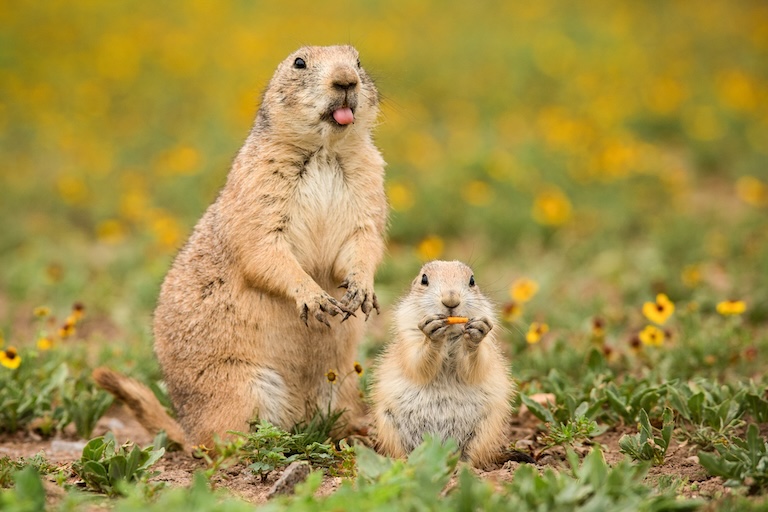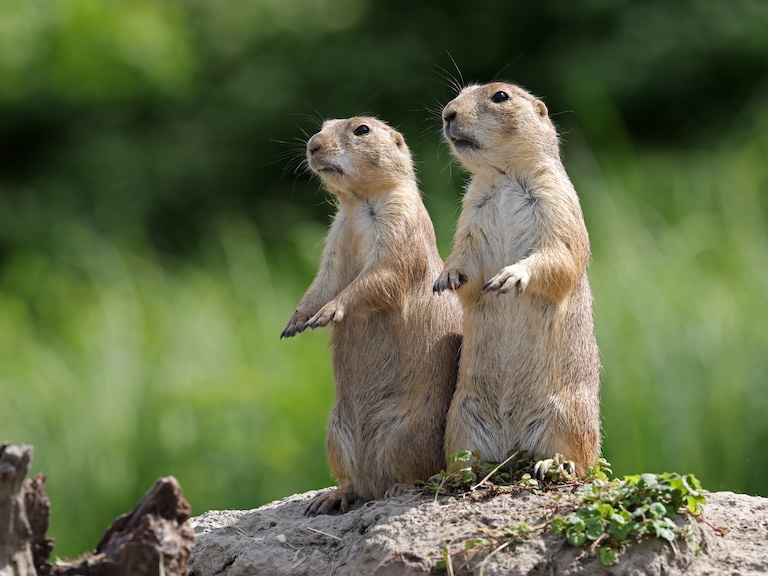Prairie Dog Profile
The North American grasslands are home to some iconic Hollywood-establishing-scene fauna. A Diamondback sitting on Route 66; an American bison grazing at the lip of the Grand Canyon; a cougar, making that weird sound cougars make outside a log cabin in the California hills. And, of course, the Bald eagle, whose call is so boring that Hollywood replaced it with that of a red-tailed hawk.
But there’s a whole genus of animals that are rarely given speaking roles, despite the fact that of all these animals, they’re the most social and vocal. These are the prairie dogs, and they’re far from a supporting act in their ecosystem, despite what the movies might tell you.

Prairie Dog Facts Overview
| Habitat: | Grasslands |
| Location: | North America |
| Lifespan: | Up to 10 years in the wild |
| Size: | Up to 40cm (16 inches) long |
| Weight: | Up to 1.5 kg (3 lb) |
| Colour: | Sandy brown |
| Diet: | Mainly grasses, roots and seeds, sometimes insects |
| Predators: | The black-footed ferret, swift fox, golden eagle, red tailed hawk, American badger, coyote, ferruginous hawk. |
| Top Speed: | Not reported |
| No. of Species: | 5 |
| Conservation Status: | Three species Least Concern, two Endangered (IUCN) |
Prairie dogs are medium-sized rodents with oversized personalities. These little squirrels are expert tunnellers but what sets them apart from most rodents is how highly social and intelligent they are.
Their bonding behaviours are remarkably complex, and their vocal language holds secrets that we have yet to fully uncover.
If they’re considered at all, they’re usually considered a pest, but prairie dogs are responsible for holding the entire ecosystem together as prey, predators, and soil engineers.
Unfortunately, 2/5 of the species are now endangered due to human development on their turf.
Interesting Prairie Dog Facts
1. They’re squirrels
Prairie dogs aren’t dogs, but you only have to look at them to figure that out. These are rodents, in the same family as the common squirrels you see in the trees. But unlike the tree squirrels, prairie dogs go the way of the marmot, and spend their lives on – or more specifically, under – the ground.
They’re ground squirrels, and as members of the squirrel family, these ones are particularly impressive.

2. They’re tough
Rodents are generally pretty badass. There are 1500 species of them and they’re the most diverse mammalian order. Most are smart, tough, and highly adaptable, and prairie dogs do nothing to lower the average in this regard.
They occupy habitats up to 3km in altitude, and in these places, the temperature can swing by more than 70°C in a year. In the same habitats, they’re exposed to hail storms, blizzards, floods, water scarcity, grassland fires, and the constant threat of being eaten on top of all of this.
So, they’ve adapted by becoming outstanding.
Burrowing into the earth protects them from most of the above, so this has become one of their strongest talents.
3. They’re accomplished diggers
Prairie dogs live in complex subterranean networks known as towns. Long-lasting towns may contain tens of thousands of individuals and span miles in each direction. Towns are subdivided into Burroughs called wards, and inside each ward, there are smaller family units called coteries or clans, depending on the species.
Each family gets a territory of roughly an acre and defends it against its neighbours. There may be up to 70 entries for each coterie, spread out around the territory.
Individual burrows will be up to 10 meters long, and descend up to 3 meters into the ground. At the entrances, there are watch tower mounds, some a meter tall, which are used to look out over the plains and stay vigilant for predators. These mounds also stop water from flooding into the burrow.
The network of tunnels is punctuated with chambers, some for night-time sleeping, others for protecting newborns.
4. They kiss
Prairie dogs are clearly social animals, but they’re also recognisably affectionate. Part of their bonding behavioural repertoire involves classic grooming behaviours, but also mouth-to-mouth contact, called kissing.
This passionate form of bonding may work pretty much exactly the same way it does in humans, to create and maintain intimate bonds between family members and mating groups. With such huge communities, it’s a great way of solidifying loyal bonds within smaller family subunits. 1

5. They talk
But there’s a lot more to their communication than touch. Prairie dog vocal communication appears to be highly detailed and rich in information.
Being primary prey species for various animals, they need to be on high alert much of the time, so they have developed calls that include information on what they’re seeing. Prairie dogs have a call for each specific predator, as well as possibly information on where it is and what it’s doing.
They also have calls for things that aren’t predators. While the intricacies of their language haven’t been fully explored yet, these highly intelligent rodents appear to have a very descriptive vocal language. 2
6. They’re ventriloquists
One struggle researchers have found when trying to follow prairie dog calls is with identifying who’s saying what. These rodents appear to have an interesting ability to ‘throw’ their voices. This may be an adaptation to predation, making their location hard to pinpoint by eavesdropping hunters.
Whatever it is, it means that picking out one individual from the crowd becomes a time-consuming and difficult task! 3
7. They’re keystone species
It’s hard to imagine such extensive communities would do anything other than deeply affect the ecosystem, but prairie dogs appear to be such huge ecosystem engineers that they’re essential to its healthy functioning.
Their tunnelling affects soil properties, controlling drainage, aeration and fertility. But their feeding behaviour is also important. Feeding on grasses, roots and seeds, they control plant populations, keeping the succession of tall plants from establishing and maintaining wide clearings from which they can spot predators more easily.
And predators rely on them for food. They are the primary source of nutrients for multiple large carnivores like ferrets, foxes and coyotes that share their habitats.
So, these small rodents are at the centre of a healthy ecosystem, and essential, keystone species as a result, directly benefitting over 150 other species. 4
8. Yet, some have an uncertain future
Three species of prairie dogs are still going strong, but two are now endangered. Both the Mexican and Utah prairie dogs are under extreme pressure from increasing human pressure, including habitat loss from livestock and other agricultural expansion.
Its range has been reduced by 65% already, and the species is locally extinct in some of its previous ranges.
The extraction of water for agriculture also affects prairie dog habitats outside of the agricultural zone, and in areas where they overlap, they’re often eradicated as pests. Livestock also bring with them diseases, and plague outbreaks have wiped out entire towns in some places.
Because these threats now apply to over 90% of the Mexican prairie dog’s range, the future looks bleak for these species.

Prairie Dog Fact-File Summary
Scientific Classification
| Kingdom: | Animalia |
| Phylum: | Chordata |
| Class: | Mammalia |
| Order: | Rodentia |
| Family: | Sciuridae |
| Genus: | Cynomys |
Fact Sources & References
- BBC (2017), “Prairie dogs kiss | Spy in the Wild – BBC”, YouTube.
- Deanna Patterson (2022), “Speaking dog: Technology could lead to device that can decipher animal communication”, CBC.
- Corinne A. Diggins (2021), “Behaviors associated with vocal communication of squirrels”, ESA.
- “Prairie Dog”, Defender of Wildlife.
